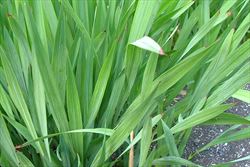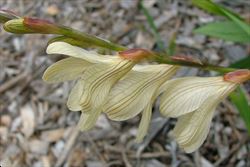Click on images to enlarge

infestation (Photo: Jackie Miles)

habit (Photo: Sheldon Navie)

habit prior to flowering (Photo: Sheldon Navie)

habit in flower (Photo: Sheldon Navie)

elongated strap-like leaves (Photo: Sheldon Navie)

flower cluster (Photo: Sheldon Navie)

whitish flowers from side-on, each with brownish-coloured bracts at the base (Photo: Sheldon Navie)

young growth in early spring (Photo: Sheldon Navie)
Scientific Name
Tritonia gladiolaris (Lam.) Goldblatt & J.C. Manning
Synonyms
Gladiolus lineatus Salisb.Ixia gladiolaris Lam.Tritonia lineata (Salisb.) Ker Gawl.
Family
Iridaceae
Common Names
chiffon lace, lined tritonia, montbretia, tritonia
Origin
Native to southern Africa (i.e. Lesotho and South Africa).
Cultivation
Lined tritonia (Tritonia gladiolaris) is commonly cultivated as a garden ornamental, particularly in the temperate regions of Australia.
Naturalised Distribution
Widely naturalised in southern and eastern Australia (i.e. in the eastern parts of central and southern New South Wales, in Victoria and Tasmania, in south-eastern South Australia and in the coastal districts of south-western Western Australia). Also rarely naturalised in the cooler sub-coastal parts of south-eastern Queensland and occasionally naturalised on Norfolk Island.
Also naturalised in New Zealand.
Habitat
A weed of grasslands, open woodlands, hillsides, roadsides, waste areas and disturbed sites in temperate regions.
Habit
An upright (i.e. erect) herbaceous plant usually growing 30-60 cm tall. It re-grows each year from long-lived (i.e. perennial) underground 'bulbs' (i.e. corms). These 'bulbs' (up to 2 cm across) and are covered in a tunic of brown netted fibres.
Distinguishing Features
- an upright herbaceous plant usually growing 30-60 cm tall and re-growing each year from long-lived underground 'bulbs'.
- its long, strap-like, leaves (7-35 cm long and 7-18 mm wide) are mostly tufted at the base of the plant.
- its tubular flowers are borne spikes containing 5-15 flowers at the tips of the flowering stems.
- these cream, white or pale yellow flowers have six 'petals' with prominent purple or blackish veins.
- its oval fruit capsules (3-8 mm long) turn brown and split open when mature.
Stems and Leaves
The slender unbranched flowering stems are green and hairless (i.e. glabrous).
The long, strap-like (i.e. linear to lanceolate), leaves are mostly tufted at the base of the plant. These leaves (7-35 cm long and 7-18 mm wide) have entire margins, pointed tips (i.e. acuminate apices), and three to five prominent parallel veins. They are hairless (i.e. glabrous) and sheathed at the base.
Flowers and Fruit
The tubular flowers are borne spikes containing 5-15 stalkless (i.e. sessile) flowers. Each flower is subtended by a brownish-coloured bract (7-12 mm long) that is slightly toothed at the tip. The six 'petals' (i.e. tepals or perianth segments) are fused together at the base into a tube (10-15 mm long) with spreading lobes 15-25 mm long. These 'petals' are cream, white or pale yellow in colour with prominent purple or blackish veins. The flowers also have three stamens and a rounded ovary (about 3 mm across) topped with a style that separates into three short branches (about 4 mm long). Flowering occurs mostly during spring (i.e. in October and November).
The oval (i.e. ellipsoid) fruit capsules (3-8 mm long and 2-3 mm wide) turn from green to brown as they mature. When fully mature they split open to release numerous rounded or angled seeds.
Reproduction and Dispersal
Lined tritonia (Tritonia gladiolaris) reproduces by seed and vegetatively via its underground 'bulbs' (i.e. corms).
The seeds may be spread by wind and water, while the seeds and corms can also be spread in contaminated soil and dumped garden waste.
Environmental Impact
Lined tritonia (Tritonia gladiolaris) is regarded as an environmental weed in Victoria, Tasmania, South Australia, Western Australia and south-eastern New South Wales.
Legislation
Not declared or considered noxious by any state government authorities.
Similar Species
Lined tritonia (Tritonia gladiolaris) is very similar to some other invasive bulbous species with whitish flowers, including freesia (Freesia alba x Freesia leichtlinii), sparaxis (Sparaxis bulbifera) and hesperantha (Hesperantha falcata). These species can be distinguished by the following differences:
- lined tritonia (Tritonia gladiolaris) flowers are white or cream, but covered with a network of thin dark brown lines. The flower styles are divided into three branches and hence they have three stigmas.
- freesia (Freesia alba x Freesia leichtlinii) flowers are white or cream, often with some purplish markings on the outside, and the lower three 'petals have yellow markings on the inside. The flower styles are divided into six branches and hence they have six stigmas.
- sparaxis (Sparaxis bulbifera) flowers are white or cream, often with some purplish markings on the outside, and their centres are usually yellow. The flower styles are divided into three branches and hence they have three stigmas.
- hesperantha (Hesperantha falcata) flowers are white or cream with a distinctive purple-brown colour on the outside of the 'petals'. The flower styles are divided into three branches and hence they have three stigmas.

